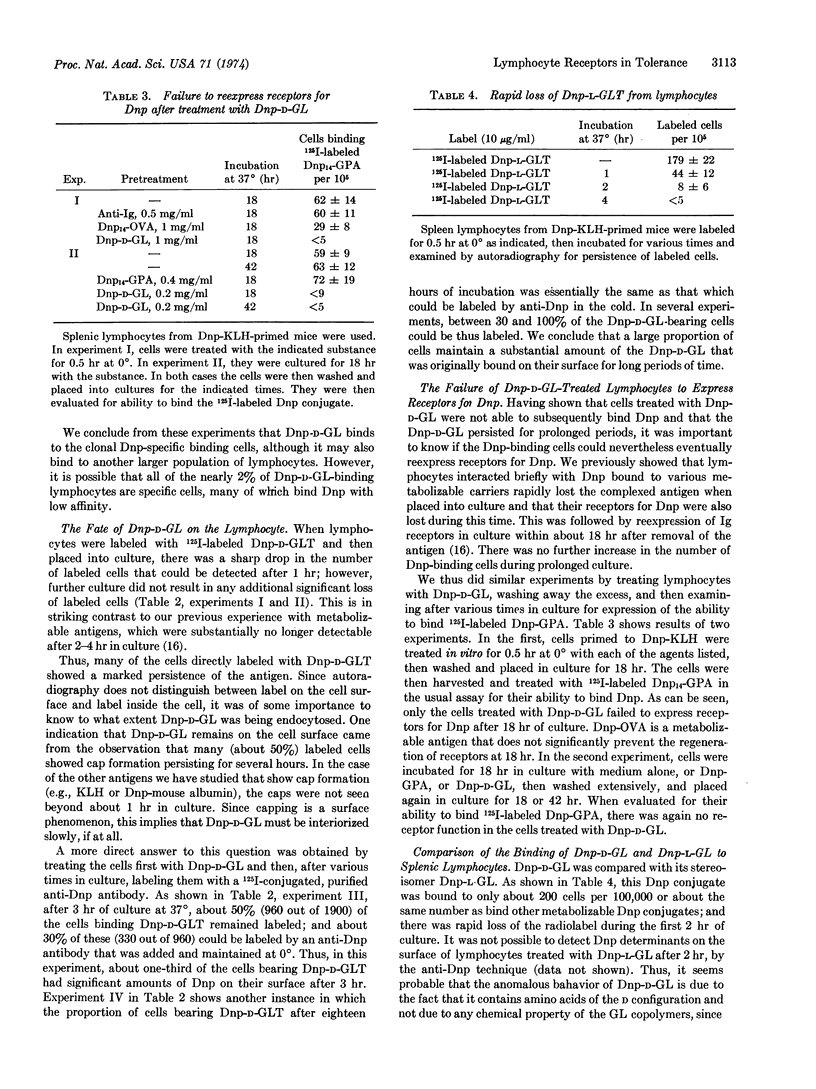Abstract
We present data concerning a strongly tolerogenic molecule made of a copolymer of D-amino acids that is not metabolizable poly(D-glutamic acid-D-lysine). The dinitrophenyl conjugate of this molecule induces profound tolerance in dinitrophenyl-specific B lymphocytes both in vivo and in vitro. We show that dinitrophenyl-poly(D-glutamic acid-D-lysine) binds to a population of lymphocytes including those specific for dinitrophenyl, that it persists for long periods on these lymphocytes and is poorly internalized by them, and that these lymphocytes are prevented from binding other dinitrophenyl compounds. Despite prolonged culture, they do not reexpress receptors for dinitrophenyl. This behavior of dinitrophenyl-poly(D-glutamic acid-D-lysine) is contrasted to that of metabolizable antigens. This finding indicates that one mechanism of tolerance induced by nonmetabolizable antigens involves the prolonged loss of B lymphocyte receptor function.
Keywords: immunoglobulin, synthetic antigens, tolerance, B lymphocytes
Full text
PDF



Selected References
These references are in PubMed. This may not be the complete list of references from this article.
- Ault K. A., Unanue E. R. Events after the binding of antigen to lymphocytes: removal and regeneration of the antigen receptor. J Exp Med. 1974 May 1;139(5):1110–1124. doi: 10.1084/jem.139.5.1110. [DOI] [PMC free article] [PubMed] [Google Scholar]
- Borel Y. Induction of immunological tolerance by a hapten (DNP) bound to a non-immunogenic protein carrier. Nat New Biol. 1971 Apr 7;230(14):180–182. doi: 10.1038/newbio230180a0. [DOI] [PubMed] [Google Scholar]
- Davie J. M., Paul W. E., Katz D. H., Benacerraf B. Hapten-specific tolerance. Preferential depression of the high affinity antibody response. J Exp Med. 1972 Sep 1;136(3):426–438. doi: 10.1084/jem.136.3.426. [DOI] [PMC free article] [PubMed] [Google Scholar]
- Fidler J. M., Golub E. S. Immunological tolerance to a hapten. I. Induction and maintenance of tolerance to trinitrophenyl with trinitrobenzene sulfonic acid. J Exp Med. 1973 Jan 1;137(1):42–54. doi: 10.1084/jem.137.1.42. [DOI] [PMC free article] [PubMed] [Google Scholar]
- Golan D. T., Borel Y. Nonantigenicity and immunologic tolerance: the role of the carrier in the induction of tolerance to the hapten. J Exp Med. 1971 Oct 1;134(4):1046–1061. doi: 10.1084/jem.134.4.1046. [DOI] [PMC free article] [PubMed] [Google Scholar]
- Hamaoka T., Katz D. H. Immunological tolerance in bone marrow-derived lymphocytes. II. Effects of allogeneic cell interactions and enzymatic digestion with trypsin or inactivated hapten-specific precursors of antibody-forming cells. J Exp Med. 1974 Jun 1;139(6):1446–1463. doi: 10.1084/jem.139.6.1446. [DOI] [PMC free article] [PubMed] [Google Scholar]
- Hamilton J. A., Miller J. F. Hapten-specific tolerance: unresponsiveness in the T cell-depleted population. Eur J Immunol. 1973 Jul;3(7):457–460. doi: 10.1002/eji.1830030716. [DOI] [PubMed] [Google Scholar]
- Havas H. F. The effect of the carrier protein on the immune response and on the induction of tolerance in mice to the 2,4-dinitrophenyl determinant. Immunology. 1969 Dec;17(6):819–829. [PMC free article] [PubMed] [Google Scholar]
- Katz D. H., Davie J. M., Paul W. E., Benacerraf B. Carrier function in anti-hapten antibody responses. IV. Experimental conditions for the induction of hapten-specific tolerance or for the stimulation of anti-hapten anamnestic responses by "nonimmunogenic" hapten-polypeptide conjugates. J Exp Med. 1971 Jul 1;134(1):201–223. doi: 10.1084/jem.134.1.201. [DOI] [PMC free article] [PubMed] [Google Scholar]
- Katz D. H., Hamaoka T., Benacerraf B. Immunological tolerance in bone marrow-derived lymphocytes. I. Evidence for an intracellular mechanism of inactivation of hapten-specific precursors of antibody-forming cells. J Exp Med. 1972 Dec 1;136(6):1404–1429. doi: 10.1084/jem.136.6.1404. [DOI] [PMC free article] [PubMed] [Google Scholar]
- Marchalonis J. J. An enzymic method for the trace iodination of immunoglobulins and other proteins. Biochem J. 1969 Jun;113(2):299–305. doi: 10.1042/bj1130299. [DOI] [PMC free article] [PubMed] [Google Scholar]
- Mitchell G. F., Humphrey J. H., Wiliamson A. R. Inhibition of secondary anti-hapten responses with the hapten conjugated to type 3 pneumococcal polysaccharide. Eur J Immunol. 1972 Oct;2(5):460–467. doi: 10.1002/eji.1830020516. [DOI] [PubMed] [Google Scholar]
- Nossal G. J., Pike B. L., Katz D. H. Induction of B cell tolerance in vitro to 2,4-dinitrophenyl coupled to a copolymer of D-glutamic acid and D-lysine (DNP-D-GL). J Exp Med. 1973 Jul 1;138(1):312–317. doi: 10.1084/jem.138.1.312. [DOI] [PMC free article] [PubMed] [Google Scholar]
- Osborne D. P., Jr, Katz D. H. The allogeneic effect in inbred mice. 3. Unique antigenic structural requirements in the expression of the phenomenon on unprimed cell populations in vivo. J Exp Med. 1973 Apr 1;137(4):991–1008. doi: 10.1084/jem.137.4.991. [DOI] [PMC free article] [PubMed] [Google Scholar]
- Unanue E. R., Karnovsky M. J. Redistribution and fate of Ig complexes on surface of B lymphocytes: functional implications and mechanisms. Transplant Rev. 1973;14:184–210. doi: 10.1111/j.1600-065x.1973.tb00107.x. [DOI] [PubMed] [Google Scholar]
- Unanue E. R., Perkins W. D., Karnovsky M. J. Ligand-induced movement of lymphocyte membrane macromolecules. I. Analysis by immunofluorescence and ultrastructural radioautography. J Exp Med. 1972 Oct 1;136(4):885–906. doi: 10.1084/jem.136.4.885. [DOI] [PMC free article] [PubMed] [Google Scholar]


